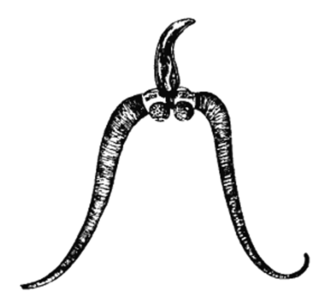
Digenea is a class of trematodes in the Platyhelminthes phylum, consisting of parasitic flatworms with a syncytial tegument and, usually, two suckers, one ventral and one oral. Adults commonly live within the digestive tract, but occur throughout the organ systems of all classes of vertebrates. Once thought to be related to the Monogenea, it is now recognised that they are closest to the Aspidogastrea and that the Monogenea are more closely allied with the Cestoda. Around 6,000 species have been described to date.

Paul Gustav Samuel Stäckel was a German mathematician, active in the areas of differential geometry, number theory, and non-Euclidean geometry. In the area of prime number theory, he used the term twin prime for the first time.

Plagiorchiida is a large order of trematodes, synonymous to Echinostomida. They belong to the Digenea, a large subclass of flukes. This order contains relatively few significant parasites of humans.

Echinostomata is a suborder of the parasitic flatworm order Plagiorchiida. The suborder contains numerous species that are parasitic in humans.

Psilostomatidae is a family of trematodes in the order Plagiorchiida. They parasitise aquatic vertebrates as definitive hosts.

Heterophyidae is a family of intestinal trematodes in the order Plagiorchiida.

Bucephalidae is a family of trematodes that parasitize fish. They lack suckers, having instead a muscular organ called a "rhynchus" at the front end which they use to attach to their hosts. The characteristics of the rhynchus are used to help define the genera of the family. It is one of the largest digenean families, with 25 genera containing hundreds of described species. Bucephalids are cosmopolitan, having been recorded all over the world. They are parasites of fish from freshwater, marine, and brackish water habitat types.
Heinrich Hermann Robert Hartmeyer was a German zoologist.

Opecoelidae is a family of trematodes. It is the largest digenean family with over 90 genera and nearly 900 species, almost solely found in marine and freshwater teleost fishes. It was considered by Bray et al. to belong in the superfamily Opecoeloidea Ozaki, 1925 or the Brachycladioidea Odhner, 1905.
Telorchis is a genus of trematode parasites found in many herps, comprising around 70 species. This parasite is an indirect parasite, with a snail intermediate host and a reptile or amphibian definitive host. Typically found in the gastrointestinal tract of their definitive host, telorchids attach to the wall of the intestinal tract with their ventral sucker, or acetabulum.
Helicometrinae is a subfamily of trematodes in the family Opecoelidae.
Philophthalmidae is a family of trematodes in the order Plagiorchiida.

Echinostomatidae is a family of trematodes in the order Plagiorchiida, first described in 1899.
Himasthlidae is a family of trematodes in the order Plagiorchiida.
Echinochasmidae is a family of trematodes in the order Plagiorchiida.
Gymnophallidae is a family of trematodes in the order Plagiorchiida.

Nils Johan Teodor Odhner was a Swedish zoologist. Odhner was born in Lund, Sweden. He was the son of the historian and archivist Clas Theodor Odhner and the father of the agronomist Clas-Erik Odhner.
Hemiuridae is a family of trematodes belonging to the order Plagiorchiida containing 514 described species.
Notocotylus is a genus of trematodes belonging to the family Notocotylidae.

Echinostomatinae is a subfamily of trematodes in the order Plagiorchiida, first described in 1899.









